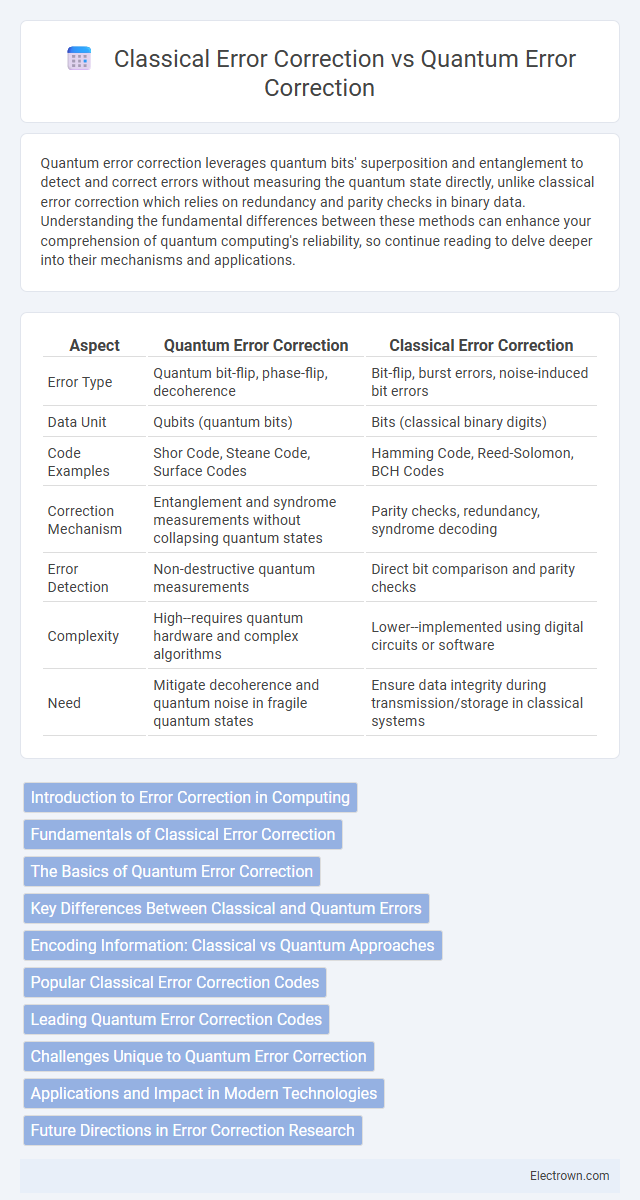Quantum error correction leverages quantum bits' superposition and entanglement to detect and correct errors without measuring the quantum state directly, unlike classical error correction which relies on redundancy and parity checks in binary data. Understanding the fundamental differences between these methods can enhance your comprehension of quantum computing's reliability, so continue reading to delve deeper into their mechanisms and applications.
Table of Comparison
| Aspect | Quantum Error Correction | Classical Error Correction |
|---|---|---|
| Error Type | Quantum bit-flip, phase-flip, decoherence | Bit-flip, burst errors, noise-induced bit errors |
| Data Unit | Qubits (quantum bits) | Bits (classical binary digits) |
| Code Examples | Shor Code, Steane Code, Surface Codes | Hamming Code, Reed-Solomon, BCH Codes |
| Correction Mechanism | Entanglement and syndrome measurements without collapsing quantum states | Parity checks, redundancy, syndrome decoding |
| Error Detection | Non-destructive quantum measurements | Direct bit comparison and parity checks |
| Complexity | High--requires quantum hardware and complex algorithms | Lower--implemented using digital circuits or software |
| Need | Mitigate decoherence and quantum noise in fragile quantum states | Ensure data integrity during transmission/storage in classical systems |
Introduction to Error Correction in Computing
Error correction in computing ensures data integrity by identifying and rectifying errors during storage or transmission. Classical error correction relies on redundancy through techniques like parity checks and Reed-Solomon codes to detect and correct bit-flips. Quantum error correction addresses unique challenges of qubit decoherence and quantum noise by encoding quantum information using entangled states and stabilizer codes, preserving superposition and entanglement properties essential for reliable quantum computation.
Fundamentals of Classical Error Correction
Classical error correction relies on redundancy, encoding data with extra bits to detect and correct errors introduced during transmission or storage. Techniques like Hamming codes and cyclic redundancy checks ensure data integrity by identifying and fixing bit flips in binary information. Your ability to recover original data depends on the code's design, which balances error detection capability and overhead, a principle foundational to digital communication and computing.
The Basics of Quantum Error Correction
Quantum error correction addresses errors in qubits caused by decoherence and quantum noise, which classical error correction cannot detect due to the no-cloning theorem. It uses entanglement and syndrome measurements to identify and correct errors without directly measuring the quantum state. Classical error correction relies on redundancy and bit-flip detection, while quantum algorithms must protect against both bit-flip and phase-flip errors simultaneously.
Key Differences Between Classical and Quantum Errors
Classical error correction deals primarily with bit flips caused by noise, where data is binary and errors are straightforward to detect and correct using techniques like parity checks or Hamming codes. Quantum error correction must address more complex errors such as bit flips, phase flips, and their combinations due to the fragile nature of quantum states and the no-cloning theorem, which prevents direct copying of qubits for redundancy. Your approach to quantum error correction requires understanding these key differences, as quantum errors involve maintaining coherence and entanglement, demanding specialized codes like Shor or surface codes to preserve quantum information.
Encoding Information: Classical vs Quantum Approaches
Quantum error correction encodes information using entangled qubits distributed across multiple physical qubits, allowing the detection and correction of quantum decoherence and bit-flip or phase-flip errors without measuring the quantum state directly. Classical error correction relies on redundant bits and parity checks that detect and correct errors through deterministic algorithms operating on binary data. The quantum approach must preserve superposition and entanglement, requiring specialized codes like the Shor or surface codes, unlike classical encoding that handles discrete, definite values.
Popular Classical Error Correction Codes
Popular classical error correction codes include Hamming codes, Reed-Solomon codes, and Turbo codes, which are designed to detect and correct errors in digital communication and storage systems. These codes utilize bit-flip detection and parity-check mechanisms to maintain data integrity over noisy channels. Unlike quantum error correction codes, classical codes operate on classical bits and can directly measure and correct errors without collapsing quantum states.
Leading Quantum Error Correction Codes
Leading quantum error correction codes such as the Surface code, Steane code, and Shor code address errors in quantum bits by leveraging entanglement and superposition, unlike classical error correction which relies on redundancy and parity checks for bits. These quantum codes are designed to protect fragile quantum information from decoherence and operational faults, enabling fault-tolerant quantum computing. Your understanding of these advanced coding methods can significantly impact the development of scalable quantum processors.
Challenges Unique to Quantum Error Correction
Quantum error correction faces unique challenges due to the fragility of quantum states and the no-cloning theorem, which prevents copying qubits for redundancy. Quantum errors are more complex, involving bit-flip, phase-flip, and amplitude damping errors, requiring sophisticated encoding schemes like stabilizer codes and surface codes. Unlike classical error correction that deals with discrete bit errors, quantum correction must address continuous error spaces without directly measuring qubit states to avoid collapsing quantum superpositions.
Applications and Impact in Modern Technologies
Quantum error correction enables reliable quantum computing by protecting fragile qubits from decoherence and operational errors, crucial for advancements in quantum cryptography, quantum communication, and high-precision quantum sensors. Classical error correction underpins the integrity of digital data transmission, storage systems, and telecommunications, ensuring minimal data loss and high reliability across modern computer networks and cloud infrastructures. The integration of quantum error correction is poised to revolutionize fields like drug discovery, optimization problems, and artificial intelligence by harnessing quantum advantages that classical error correction cannot address.
Future Directions in Error Correction Research
Future directions in error correction research emphasize the development of hybrid quantum-classical codes that leverage the strengths of both paradigms to enhance fault tolerance in quantum computing. Innovations in topological quantum codes and machine learning-based decoding algorithms aim to improve error detection and correction rates beyond classical capabilities. Your understanding of these advancements will be crucial as they pave the way for scalable, reliable quantum processors in real-world applications.
quantum error correction vs classical error correction Infographic

 electrown.com
electrown.com